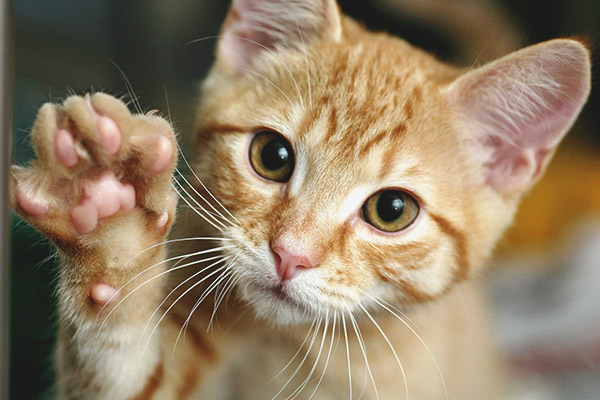The content of the article
Many owners of cats and cats are convinced that these animals are quite reasonable and that they can, like dogs, teach various teams. Most of them are often interested in how to teach a pet to give a paw or, for example, sit. The secret is simple - you need only a responsible approach to the learning process, and in the end the pet will show its best results. If you don’t have time to train yourself, you can add children who like to spend a lot of time with fluffy pets. More details about all the intricacies of the training of cats can be found in this article.
How to understand that a cat can learn something?
It is known that cats are animals that walk on their own. And to learn any command pet will only if he wants it.Sometimes it is impossible to train a cat to give a paw only because the usual team is not interested in it. With great enthusiasm, she will begin to listen if you add some zest to the process or dilute it with additional games.
Also pay attention to the nature of the cat. If the pet is capricious and very intractable, then you should not even try to teach him to give a paw - he will never do that. But with a cat who genuinely loves his master, and also has a mobile and curious character, something might work out.
Fundamental rules
Before you start training, you should pay attention to some rules. Their observance will help to make the process not only easier, but also more efficient. So, below are a few rules with which you can train a cat to serve a paw.
Rule 1. Before meals. It is best to try to teach the cat to give a paw about an hour before eating. Thus, the food will be an incentive for the cat to begin to execute commands.
Rule 2. Promotion. It’s no secret that, without additional delicacy, it’s not that a cat — even a dog will not execute the command.That is why the cat should be periodically encouraged for his efforts.
Rule 3. More attempts - more goodies. This rule will allow you to train the cat as quickly as possible, as well as give him the opportunity to arrange a holiday to his stomach.
Rule 4 Hand odorless. When training, it is important to give the cat only that hand that does not smell like any kind of food. Otherwise, instead of giving the paw, the cat will start to lick the palm and bite it.
Rule 5. The earlier the better. The fact remains that at an early age, any animals, including humans, are more susceptible to new knowledge. That is why you should start training a cat from an early age.
Rule 6. The main thing is regularity. It is very important to conduct classes constantly and in a certain period of time. This will allow the animal to quickly remember the command.
The only time to interrupt training is if the cat or cat is in some kind of discomfort or is in a very drowsy state. It is necessary for the process of training to become for the animal pleasure, not torture. Then the result will be appropriate.
What not to do during the training?
Sometimes a pet categorically refuses to learn to give a paw, and the reason for this is the owners' mistakes, which mis-organize the process itself. To avoid various mistakes, you should use some tips:
- You do not need to grab the cat by the paw and hold it, showing the pet how he should give the paw. Firstly, it will only scare the pet, and secondly, the animal can bite or scratch the owner.
- Punishing an animal for poorly performing a command is also a bad idea. If the owner of the cat starts to spank him, scold or raise his voice to the animal, then the process of training can later be forgotten altogether, since the animal finally disappears all desire. It is best to pay attention to a positive result and praise the cat, even for the fact that he did not run away from trying to teach him to give his paw. In addition, the situation can save the periodic encouragement of a pet delicacy.
- It is not recommended to delay daily training for several hours - this exhausts both the cat and the owner. It is best to devote no more than five minutes to this process.Thus, there will always be time for teaching the team and the owner, and the cat will not get tired, but, on the contrary, will even begin to enjoy.
Of course, the process of teaching a cat to even one team is significantly different from the process of training the same team of dogs. It is very important to be patient in order to achieve a real result. And if an idea has arisen in your head to teach a cat to give a paw, you should first think whether it will be possible to implement it, taking into account all the rules and advice. If the answer is no, it is recommended to discard the idea.
Some features
Cats have amazing paws with incredible sensitivity. That is why the animal is very careful about the various touches of a person to his extremities. Actually, this is one of the reasons why it is not so easy to teach a pet to give a paw. There are several features that are worth paying attention to during training:
- The paw of a cat does not clutch, and under it the palm is simply brought. She acts as a support on which the cat can freely lay a paw.
- Always during training you need to communicate with your pet in a calm voice.If a command is given, then intonation can be given a little bit of perseverance, but you do not need to raise your voice or start demanding a particular task from the cat. Given this moment, the pet will understand the seriousness of the mood and, perhaps, learn to give a paw.
- If the cat is in an excited state, it is better to postpone classes, as the animal is currently not able to understand what is happening.
Training is a process that requires a painstaking and serious attitude. And the training of cats is no exception.
Video: how to teach a cat to give a paw



 1 votes, on average: 4,00 out of 5
1 votes, on average: 4,00 out of 5







To send